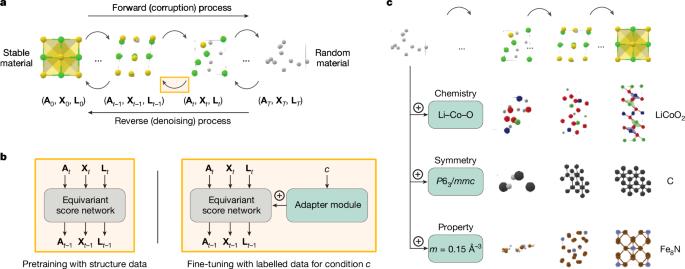A generative model for inorganic materials design
IF 48.5
1区 综合性期刊
Q1 MULTIDISCIPLINARY SCIENCES
引用次数: 0
Abstract
The design of functional materials with desired properties is essential in driving technological advances in areas such as energy storage, catalysis and carbon capture1–3. Generative models accelerate materials design by directly generating new materials given desired property constraints, but current methods have a low success rate in proposing stable crystals or can satisfy only a limited set of property constraints4–11. Here we present MatterGen, a model that generates stable, diverse inorganic materials across the periodic table and can further be fine-tuned to steer the generation towards a broad range of property constraints. Compared with previous generative models4,12, structures produced by MatterGen are more than twice as likely to be new and stable, and more than ten times closer to the local energy minimum. After fine-tuning, MatterGen successfully generates stable, new materials with desired chemistry, symmetry and mechanical, electronic and magnetic properties. As a proof of concept, we synthesize one of the generated structures and measure its property value to be within 20% of our target. We believe that the quality of generated materials and the breadth of abilities of MatterGen represent an important advancement towards creating a foundational generative model for materials design. MatterGen is a model that generates stable, diverse inorganic materials across the periodic table and can further be fine-tuned to steer the generation towards a broad range of property constraints.

无机材料设计的生成模型
设计具有理想性能的功能材料对于推动储能、催化和碳捕获等领域的技术进步至关重要。生成模型为材料设计提供了一个新的范例,通过给定所需的性能约束直接生成新材料,但目前的方法在提出稳定晶体方面成功率低,或者只能满足有限的一组性能约束4−11。在这里,我们提出了MatterGen,这是一个模型,可以在元素周期表中生成稳定、多样化的无机材料,并可以进一步微调,以引导生成更广泛的属性约束。与之前的生成模型4,12相比,MatterGen生成的结构新颖和稳定的可能性是原来的两倍多,距离局部能量最小值的距离是原来的10倍多。经过微调,MatterGen成功地生产出稳定的新型材料,具有理想的化学、对称性、机械、电子和磁性能。作为概念验证,我们合成了一个生成的结构,并测量了其属性值在我们目标的20%以内。我们相信,生成材料的质量和MatterGen能力的广度代表了为材料设计创建基础生成模型的重大进步。
本文章由计算机程序翻译,如有差异,请以英文原文为准。
求助全文
约1分钟内获得全文
求助全文
来源期刊

Nature
综合性期刊-综合性期刊
CiteScore
90.00
自引率
1.20%
发文量
3652
审稿时长
3 months
期刊介绍:
Nature is a prestigious international journal that publishes peer-reviewed research in various scientific and technological fields. The selection of articles is based on criteria such as originality, importance, interdisciplinary relevance, timeliness, accessibility, elegance, and surprising conclusions. In addition to showcasing significant scientific advances, Nature delivers rapid, authoritative, insightful news, and interpretation of current and upcoming trends impacting science, scientists, and the broader public. The journal serves a dual purpose: firstly, to promptly share noteworthy scientific advances and foster discussions among scientists, and secondly, to ensure the swift dissemination of scientific results globally, emphasizing their significance for knowledge, culture, and daily life.
 求助内容:
求助内容: 应助结果提醒方式:
应助结果提醒方式:


